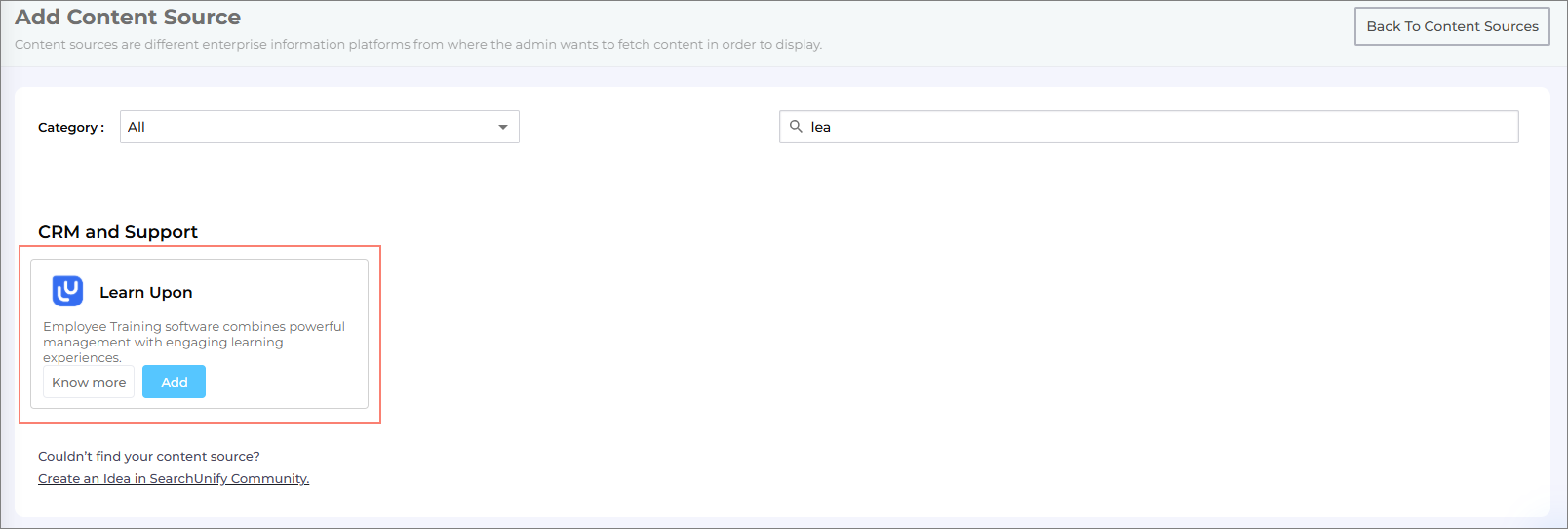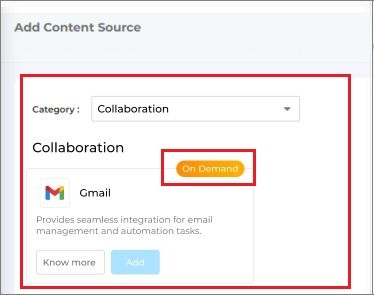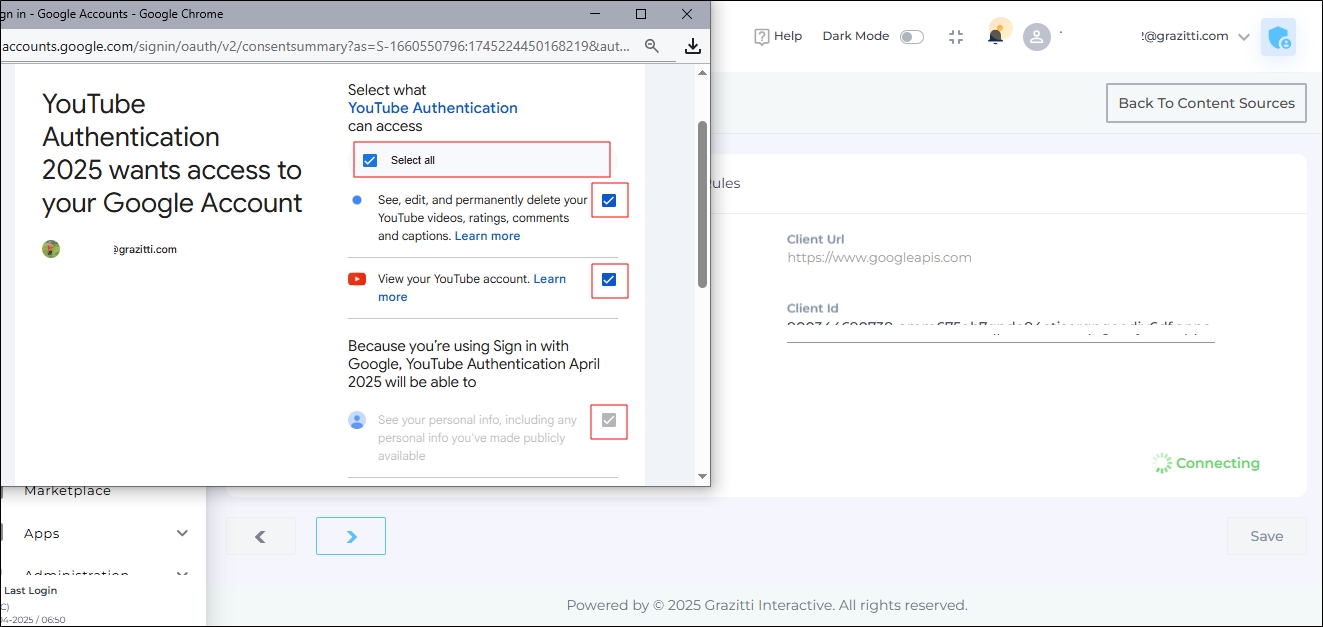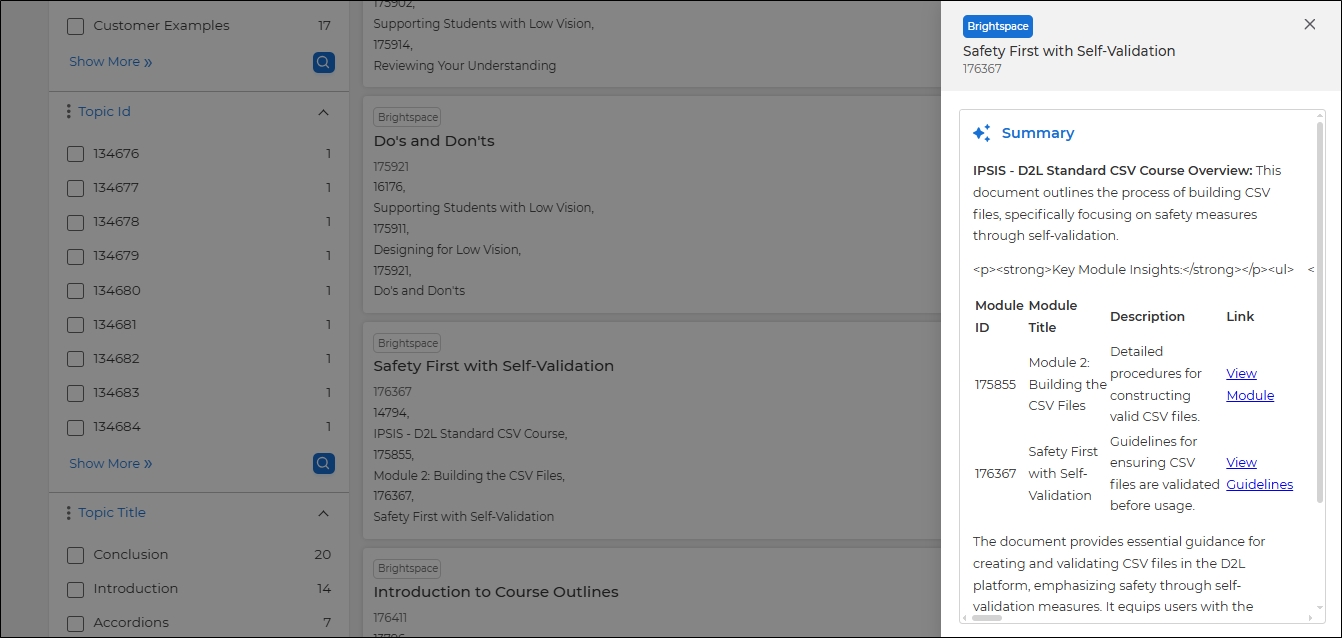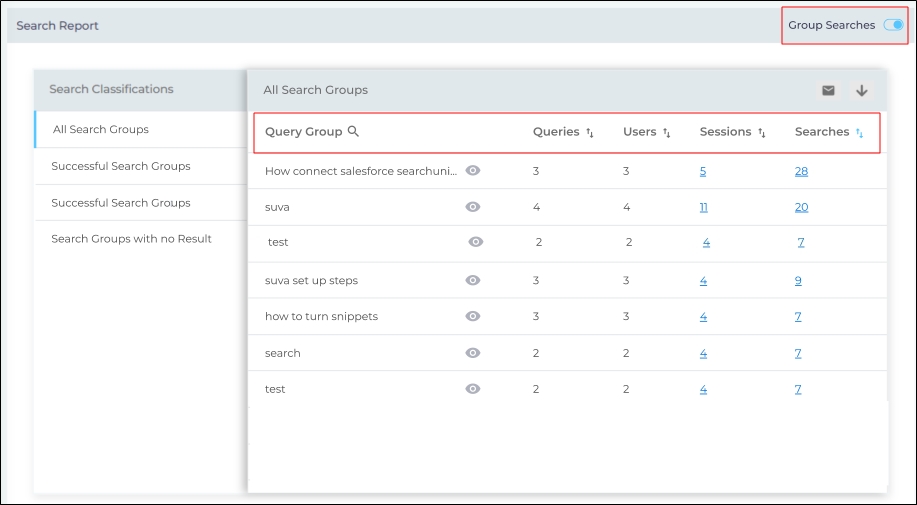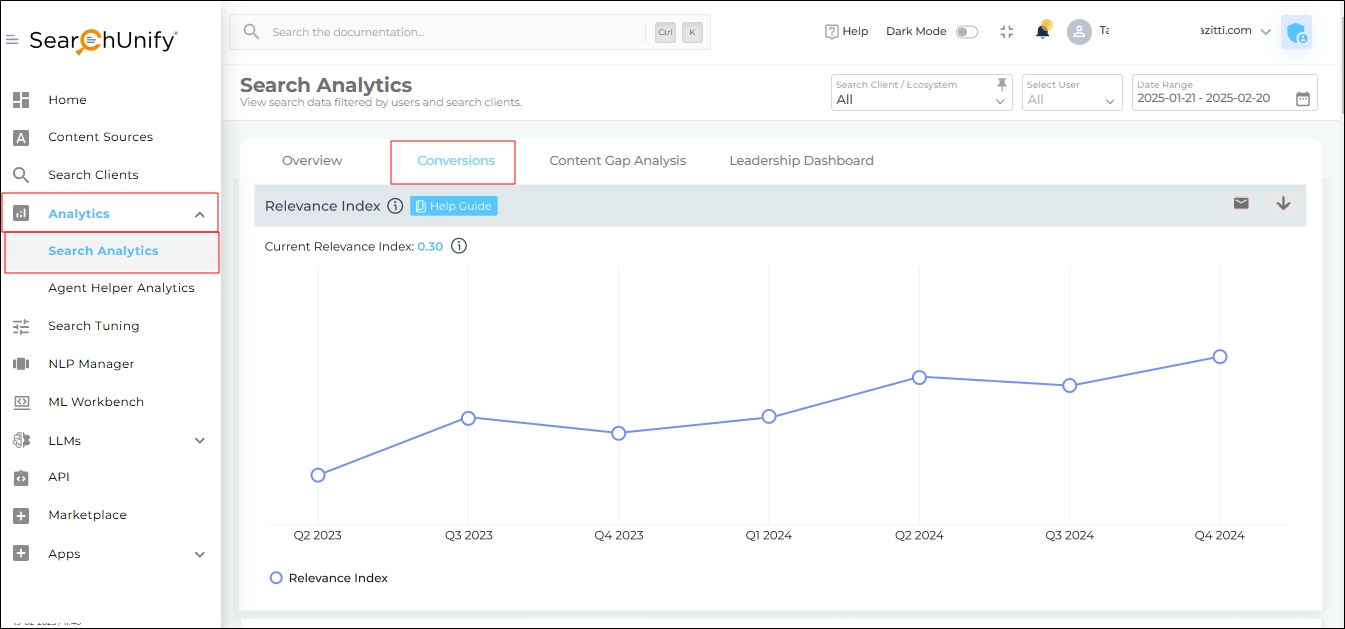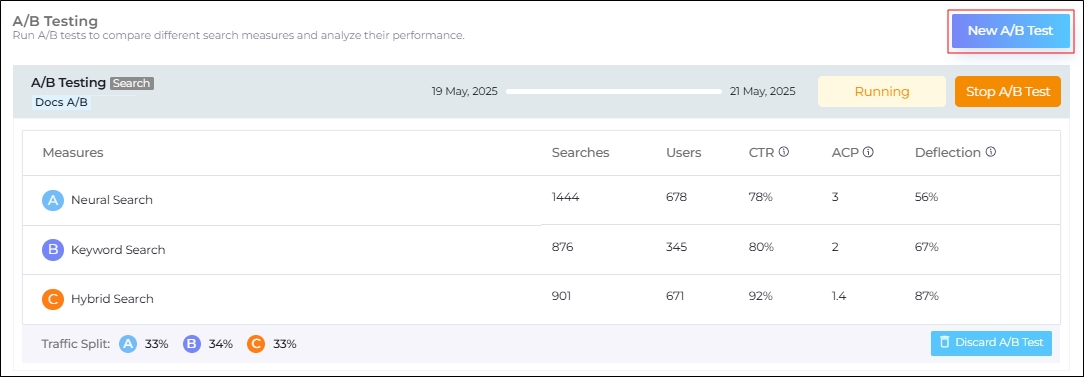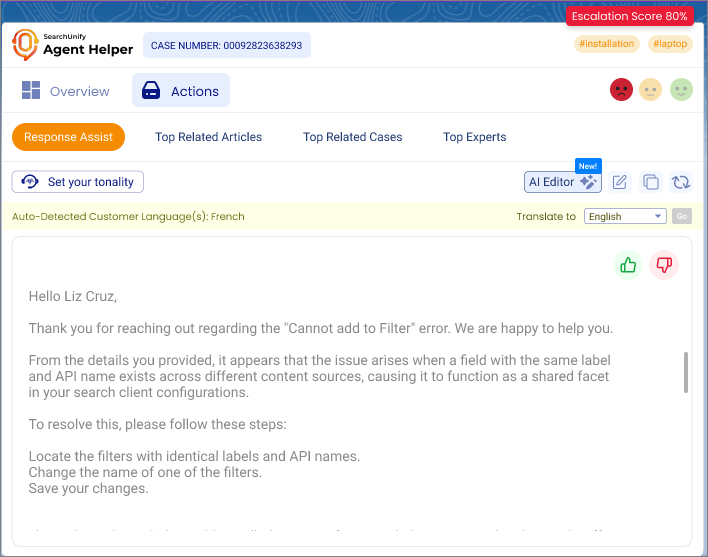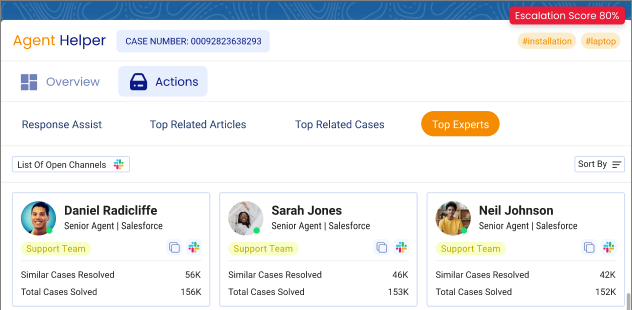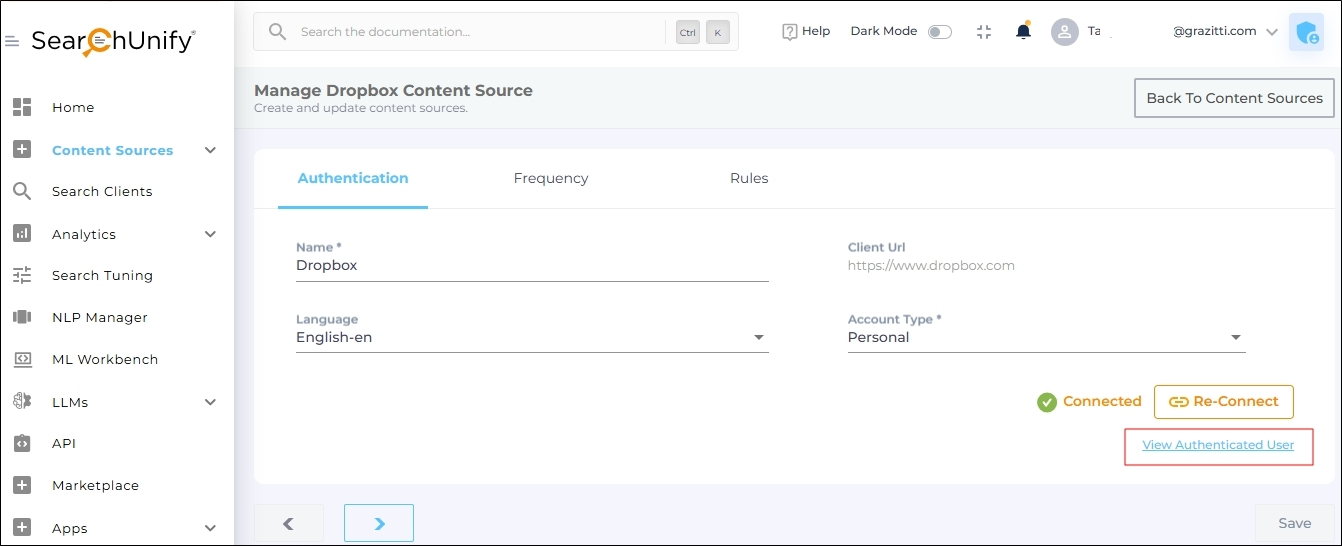Release Notes: SearchUnify Q2 '25
We're delighted to announce the arrival of the Q2 ’25 release. Experience smarter search, sharper analytics, and a more intuitive interface designed to elevate your journey with SearchUnify. Dive in and benefit from these impactful updates.
Key Highlights
The key highlights of the Q2 ‘25 release include:
-
Support for new Content Sources: LearnUpon, Freshdesk and Freshservice.
-
Four new on-demand Content Sources: Gmail, Simpplr, Airtable and GitLab.
-
New filter in the Relevance Index report.
-
Search query grouping in Search Report.
-
A/B Test on Search Clients.
-
Summarized Search Results with GenAI
-
Automatic language detection and translation in Agent Helper.
-
Slack messages to top experts with a single click in Agent Helper.
Content Sources
New Content Source: LearnUpon
LearnUpon is a powerful Learning Management System (LMS) used by numerous organizations to create and manage learning programs for their employees, customers, and partners. LearnUpon LMS is now supported out-of-the-box. Admins can index courses to make learning content searchable across SearchUnify.
Fig. A snapshot of the LearnUpon content source.
More information: Use LearnUpon as a Content Source
New Content Source: Freshdesk
Admins can now index Freshdesk tickets, articles, and topics to make them searchable. This AI-powered support platform from Freshworks enhances customer service with advanced ticketing, automation, and multi-channel integration.
Fig. A snapshot of the LearnUpon content source.
More information: Use Freshdesk as a Content Source
New Content Source: Freshservice
SearchUnify now supports Freshservice out-of-the-box. Admins can index articles and tickets to make them searchable. This process automation tool enhances IT, ops, and business team efficiency with AI-driven insights and integrations.
Fig. A snapshot of the Freshservice content source.
More information: Use Freshservice as a Content Source
New On-Demand Content Sources: Gmail, Simpplr, Airtable and GitLab
SearchUnify now supports four new on-demand Content Sources Gmail, Simpplr, Airtable and GitLab. To enable any of these, please contact the SearchUnify team.
Fig. A snapshot of the on-demand Content Source.
Update YouTube Permissions
Admins can now use Update Permissions to change the access scopes granted to the SearchUnify crawler after authenticating a YouTube content source at least once.
While authenticating a YouTube content source, SearchUnify admins can select from these three permissions scopes:
-
See, edit, and permanently delete your YouTube videos, ratings, comments and captions.
-
View your YouTube account.
-
Select the See your personal info, including any personal info you've made publicly available.
By default, “Select the See your personal info, including any personal info you've made publicly available “ permission is already selected.
Fig. A snapshot of the Update Permissions checkbox.
More information: Use YouTube As a Content Source
Enhanced Preview Search Results from All Content Sources
Previously limited by domain restrictions and video-based content sources, the Preview Search Results feature introduced in Mamba '21 can now be used across all Search Clients and Content Sources, regardless of domain configuration and video based content source. Admins can enable it through Search Clients > Edit > Configurations.
Fig. A snapshot of the Preview pane in plain text view.
More information: Preview Search Results and Configure the Content Sources (Preview Results)
Search Clients
GenAI-powered Summarized Search Results
A new feature Summarize Results is introduced in Search Clients > Edit > Configurations for web-based (not for Salesforce) Search Clients. When enabled, search users can simply click the Summarize button on the search results page to instantly generate concise, intelligent summaries for each result.
The Summarize button simplifies lengthy results into concise summaries, saving time and enhancing the search experience.
Fig. A summarized result on a web search client.
More information: Summarize Results
Freshservice Search Client
Freshservice is the latest platform to join the suite of Search Clients in SearchUnify. This new addition expands our horizon of platforms where SearchUnify's search can be deployed and it sets the stage for smarter, more contextual search experiences within the Freshservice ecosystem.
More information: Install a Search Client in Freshservice
Search Analytics
Identify Search Patterns with "Group Searches"
The Group Searches feature has been introduced in the Search Report in Search Analytics > Overview. This feature automatically clusters similar search queries into groups. By looking at these clusters, the admins can:
-
Understand User Intent: The feature clusters queries that express the same or similar user intent, even if they use different words or phrasing. For example, queries about "Mars" might be seeking information on the planet, the candy bar, or a Roman god. Query clustering allows you to identify and separate these distinct intents, which is not possible when looking at individual queries alone.
-
Uncover Search Trends with Ease: Instead of analyzing millions of unique queries, query clustering condenses them into a manageable set of representative groups. This simplification makes it easier to detect trends, measure performance, and prioritize optimizations.
-
Enhance Personalization and Targeting: By identifying clusters of similar queries, teams can tailor content to specific user segments, leading to improved engagement and conversion rates.
Fig. A snapshot of the Search Report when the Group Searches feature is on.
More information: Search Report (Group Searches)
Filter the Relevance Index Report by User Type
This release introduces a major improvement to the Relevance Index report introduced in the previous release. After upgrading to this release, the admins can filter the data displayed in the relevance index report by users. It means that they can view how well the search results align with the search users' expectations for:
-
All users
-
Internal Users
-
External Users
-
External-Only Users
The admins can use the Select User dropdown to select a user type.
Fig. The Relevancy Index Report in Search Analytics Conversions.
More information: Relevance Index
API
SUVA API Launched
SearchUnify admins can now interact with SUVA through an API. This feature enables them to interact with the chatbot using an API interface. To access the new API, admins must have one of the following scopes: All or SUVA.
Fig. A snapshot of the API Quota screen. The selected scope is "SUVA."
More information: Get Client ID and Client Secret with an API App
API Clients Linked with User Profiles
API Clients are now linked with user profiles. It means that the admins don’t have to specify their username and password to generate access tokens. The updated CURL call for generating the tokens looks like this:
curl --location --request POST 'https://yourcompany.searchunify.ai/oauth/token' \
--header 'Content-Type: application/x-www-form-urlencoded' \
--header 'Authorization: Basic {{authentication_code}}' \
--header 'Cache-Control: no-cache' \
--data-urlencode 'grant_type=client_credentials’The current API clients will continue to function but the users will see a Legacy tag appended to them.
More information: Get Access and Refresh Token Using curl
A/B Test
Data-Backed Decisions with A/B Test
With the A/B Test reports for Search Clients, administrators can obtain data on the impact of each search method on key metrics within just 24 hours. The A/B Test feature allows the creation of sub-search clients, each powered by a different search variant. For example, sub-search client A might use keyword search, sub-search client B could use neural search, and sub-search client C could use hybrid search.
Admins have full control over the percentage of traffic each sub-search client receives and can run A/B Test for durations ranging from a single day to 90 days. At the conclusion of the test, a report is generated. This report details the performance of each variant across three key metrics:
-
Average Click Position (ACP)
-
Click-Through Rate (CTR)
-
Case Deflection
You can now split your audience, try different search settings, and see what works best with real-time reports. While some admins stick with familiar keyword search, others are keen to try neural or hybrid search but want data-backed proof of gains in case deflection, click-through rate, and average click position.
Fig. A snapshot of A/B Testing report.
More information: What is A/B Test, A/B Test Overview and Implementing A/B Test for Search
Administration
Streamlined Admin Logs for Content Sources
Admin Logs now capture only changes made under the Content Sources tab, eliminating unrelated user activity to provide cleaner, more relevant records.
Changes are now logged for actions like adding, editing, or deleting content sources, updating authentication or crawl frequency, modifying rules or annotations, managing crawl actions, and handling document operations.
Users can now click View Details to see changes, organized by tabs such as Authentication, Configuration, Frequency, Rules, Content Annotation, and Crawling Cases.
Fig. A snapshot of the detailed Admin Logs for Content Source.
More information: View Instance Manager Activity in Admin Logs
Agent Helper
Agent Helper as a Standalone Application for Zendesk
Agent Helper is now compatible with Zendesk as a standalone application, removing platform dependencies and expanding availability. It was earlier available only as a native app for Salesforce.
NOTE: Agent Helper for Zendesk platform will be available from the Q3 ’24 release onwards.
More information: Configure Agent Helper in Zendesk Support
Dynamic Language Detection and Translation in Agent Responses
This feature enhances multilingual support by automatically detecting the customer's preferred language and allows agents to translate their responses directly within the ticket interface.
Fig: A snapshot of Dynamic Language Detection and Translation on Response Assist screen.
NOTE:
Only English and the detected language are supported within a single conversation.
Agents cannot preview both the original and translated text side by side.
Translation accuracy may vary, especially for uncommon dialects or mixed-language inputs.
Agents must review and refine translations when handling sensitive communication.
More information: Agent Helper Actions: Using AH in Salesforce Service Console
Share Case Details with Support Agents via Slack
Earlier agents could only share case details in open Slack channels via Agent Helper > Actions > Top Experts.
Now, they can share cases directly with individual support agents, enabling quicker collaboration and expert feedback.
Fig: A snapshot
of the Slack
( ) button for
individual
experts on the
Top Experts
screen.
) button for
individual
experts on the
Top Experts
screen.
NOTE:
Slack sharing is restricted to assigned agents only and is not available for queues, groups, or unauthorized users.
Slack integration must be configured in the SearchUnify admin panel for Agent Helper.
HTML markdown limitations may affect formatting.
If the case summary is missing, the system will use the case description instead.
Escalation Predictor
Improved Prediction Model for Better Escalation Predictions
The prediction model used to predict possible escalation has been upgraded for improved accuracy and reliability. The upgraded model was tested, and the results showcased significant improvement in detecting potential escalations and providing proactive support.
Other Updates
-
Enhanced Search Client and SearchUnifyGPT™ UI.
-
New way to generate access and refresh tokens for API Clients.
-
The field "Choose a Date” was removed from several Content Sources. In the Content Sources , the “Choose a Date”' dropdown on the Frequency tab is no longer enabled for 10 content sources.
-
View the authenticated user’s name or email for several content sources using the new View Authenticated User button. The user authenticating the content source is assigned an access token. In some content sources, the access token is linked to a name, while in others, it is linked to an email address.
Fig. A snapshot of the View Authenticated User button.
-
API Clients Linked with User Profiles i.e. admins don’t have to specify their username and password for generating refresh and access tokens. The current API clients will continue to function but the users will see a Legacy tag appended to them.
Fig. Snapshot of Legacy API clients.
Good to Know Info
Never miss an update again! Check out our fresh What’s New page to explore the latest improvements, features, and fixes.


